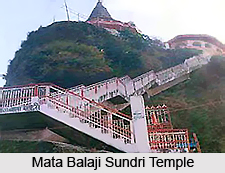 Mata Balaji Sundri Temple is locates in Kathua district of J&K. The temple dates back to over 2000 years in its construction, situated 5000 feet above sea level. The temple lies snugly in the middle of a mango grove. Legend has it that once when a Brahmin was cutting grass, his sickle struck a stone that started exuding blood. He thus placed the stone under a banyan tree and started worshipping it. That very stone is enshrined as the key idol inside the Mata Balaji Sundri Temple. A grand fair is held in the Navratri period. The temple is easily approachable by road through regular bus service from Kathua, 13km away. The nearest railhead is Kathua Railway Station.
Mata Balaji Sundri Temple is locates in Kathua district of J&K. The temple dates back to over 2000 years in its construction, situated 5000 feet above sea level. The temple lies snugly in the middle of a mango grove. Legend has it that once when a Brahmin was cutting grass, his sickle struck a stone that started exuding blood. He thus placed the stone under a banyan tree and started worshipping it. That very stone is enshrined as the key idol inside the Mata Balaji Sundri Temple. A grand fair is held in the Navratri period. The temple is easily approachable by road through regular bus service from Kathua, 13km away. The nearest railhead is Kathua Railway Station.
This article is a stub. You can enrich by adding more information to it. Send your Write Up to content@indianetzone.com





















